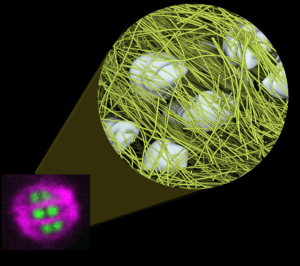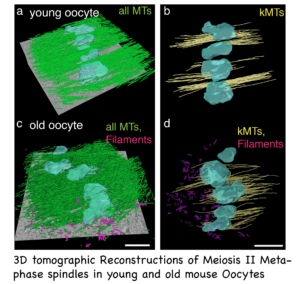Spindle assembly during meiosis in C. elegans and Mouse
About
 The faithful segregation of Chromosomes is fundamental to life. Surprisingly, chromosome segregation errors are remarkably common in oocyte meiosis and give rise to aneuploidy, a major cause of infertility and pregnancy loss.
The faithful segregation of Chromosomes is fundamental to life. Surprisingly, chromosome segregation errors are remarkably common in oocyte meiosis and give rise to aneuploidy, a major cause of infertility and pregnancy loss.
We currently focus on one major project on meiosis in our lab:
Age related aneuploidy
Cell division is a complex but fundamental life process. Among its many other purposes, it is needed for a fertilized egg to develop into a human being, for our wounds to heal, for infections to clear and for our bodies to sustain life. Whenever a cell divides, its genetic information is duplicated and packaged into chromosomes which are then separated and equally distributed between the new daughter cells. For the newly formed cells and ultimately the body to be healthy, distribution of the chromosomes should be highly accurate. Accurate chromosome separation during cell division is driven by dynamic cellular
cables that are connected to special chromosomal regions known as centromeres. Indeed, defects in centromere formation or function compromise chromosome separation and lead to daughter cells containing too many or too few chromosomes, a hallmark of cancerous cells.
 When eggs are prepared for fertilization, a specialized form of cell division called meiosis separates the chromosomes. Here, the accuracy of chromosome separation during meiosis determines whether a fertilized egg can develop into a healthy human being. Surprisingly, meiosis in humans and other mammals is highly prone to errors and often leads to eggs that contain the wrong number of chromosomes. Fertilization of such chromosomally abnormal eggs frequently leads to human embryo deaths and conditions such as Down’s syndrome. Complications arising from erroneous chromosome separation in eggs become even more frequent as women get older. Research in the field of meiosis has only scratched the surface of why chromosome separation in eggs is highly error-prone. Furthermore, the reasons behind the deterioration in the quality of this process as women get older largely remain unknown.
When eggs are prepared for fertilization, a specialized form of cell division called meiosis separates the chromosomes. Here, the accuracy of chromosome separation during meiosis determines whether a fertilized egg can develop into a healthy human being. Surprisingly, meiosis in humans and other mammals is highly prone to errors and often leads to eggs that contain the wrong number of chromosomes. Fertilization of such chromosomally abnormal eggs frequently leads to human embryo deaths and conditions such as Down’s syndrome. Complications arising from erroneous chromosome separation in eggs become even more frequent as women get older. Research in the field of meiosis has only scratched the surface of why chromosome separation in eggs is highly error-prone. Furthermore, the reasons behind the deterioration in the quality of this process as women get older largely remain unknown.
Our lab, in collaboration with the labs of Dr. Mogessie (University of Bristol) and Dr. Fachinetti (Institute Curie, France) will test the hypothesis that defects in centromere function that accompany ageing may contribute to poor quality of eggs in older women. In addition we are quantifying additional structural differences between spindle sof young and old oocytes.
More reading
Redemann S, Lantzsch I, Lindow N, Prohaska S, Srayko M, Müller-Reichert T. A Switch in Microtubule Orientation during C. elegans Meiosis.Curr Biol. 2018 Sep 24;28(18):2991-2997.e2. doi: 10.1016/j.cub.2018.07.012. Epub 2018 Sep 6. PubMed PMID: 30197085.
Yu, C. H., Redemann, S., Wu, H. Y., Kiewisz, R., Yoo, T. Y., Conway, W., … & Needleman, D. (2019). Central-spindle microtubules are strongly coupled to chromosomes during both anaphase A and anaphase B. Molecular biology of the cell, 30(19), 2503-2514.
